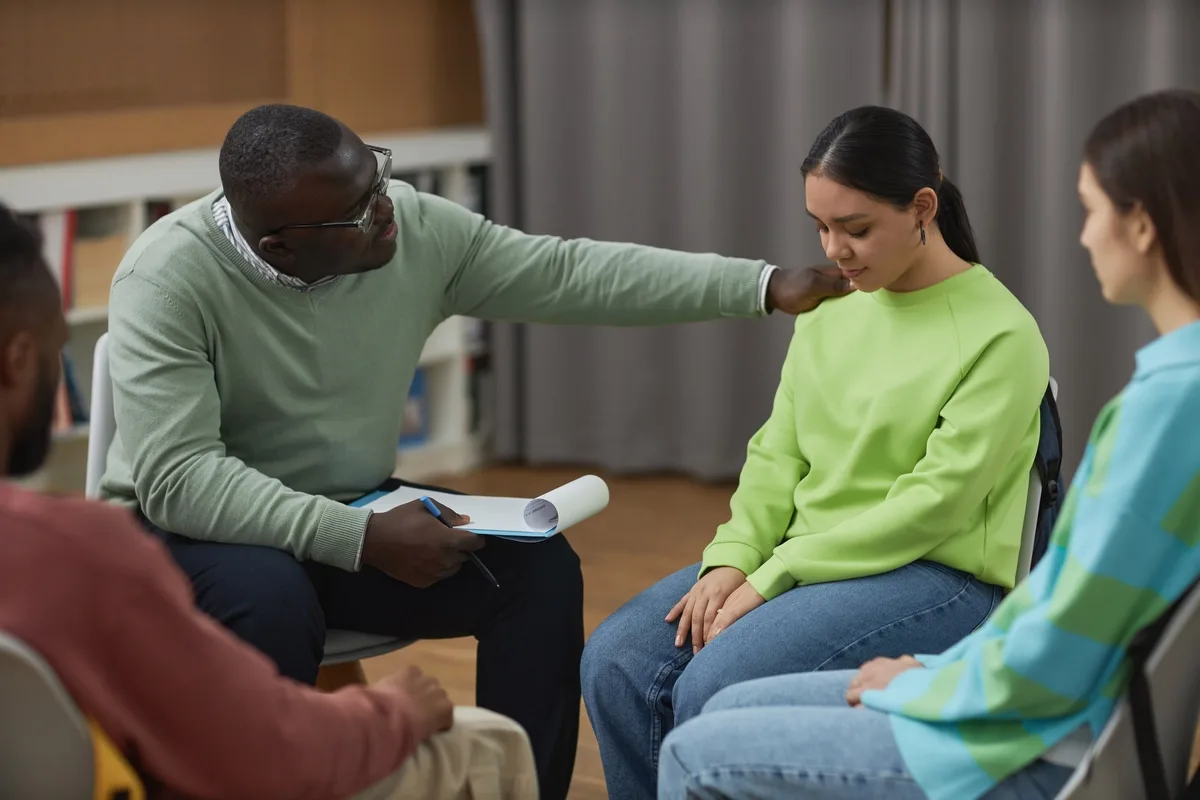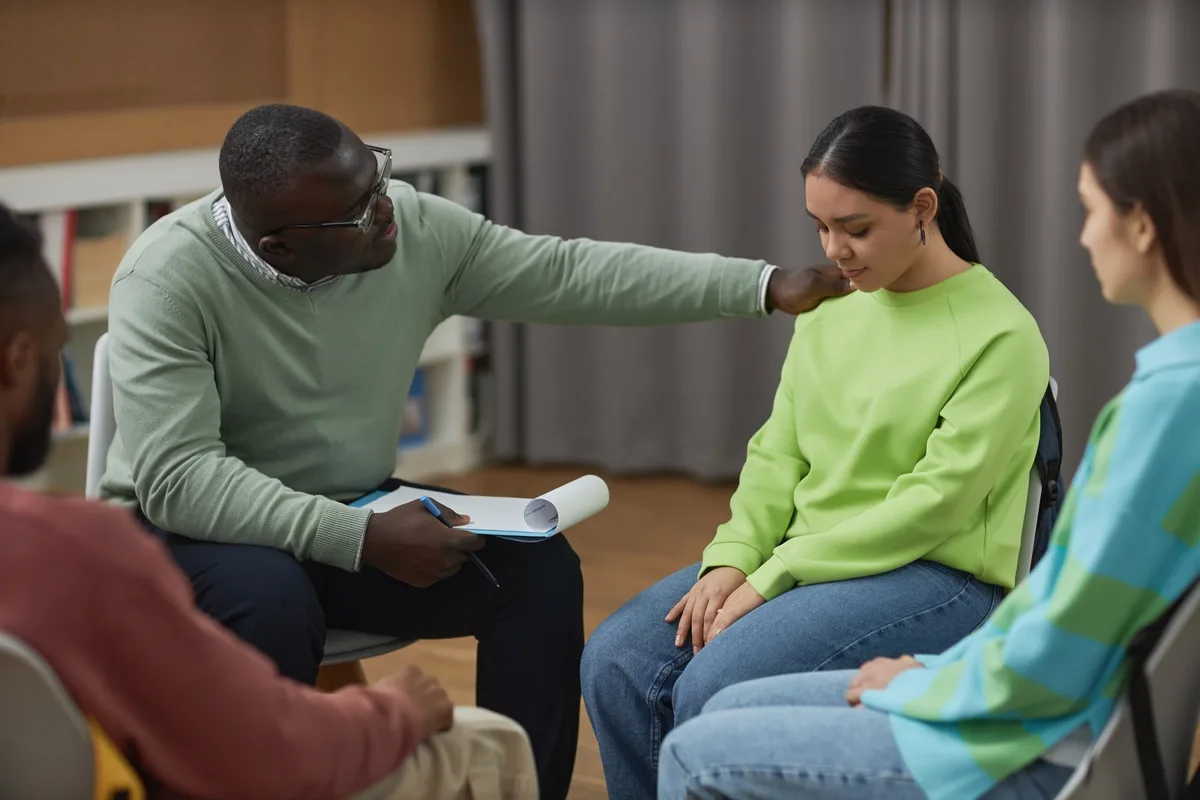24/7 Helpline:
(866) 899-221924/7 Helpline:
(866) 899-2219
Learn more about Ecstasy Detox centers in San Francisco County
Ecstasy Detox in Other Counties

Other Insurance Options

BHS | Behavioral Health Systems

Sliding scale payment assistance

UnitedHealth Group

Evernorth

WellCare Health Plans

Excellus

Horizon Healthcare Service

MVP Healthcare

Magellan

Kaiser Permanente

Access to Recovery (ATR) Voucher

Absolute Total Care

Private insurance

United Health Care

American Behavioral

Amerigroup

Meritain

Humana

UMR

Magellan Health

Felton Institute – Geriatric Outpatient Mental Health Services
Felton Insitute - Geriatric Outpatient Mental Health Services is a non-profit rehab located in San F...

LWCC – Lee Woodward Counseling Center for Women
LWCC – Lee Woodward Counseling Center for Women is a non-profit rehab located in San Francisco, Cali...

Ohlhoff Recovery House
Ohlhoff Recovery House is an addiction treatment center for adults, located in San Francisco, Califo...

Salvation Army – Harbor Light Center
Salvation Army- Harbor Light Center, located in San Francisco, California, is for individuals who ar...

TLC Residential Homes – 36th Ave
TLC Residential Homes - 36th Ave is a sober living home for individuals in need of a clean and sober...

San Francisco AIDS Foundation – Substance Health
San Francisco AIDS Foundation – Substance Health is a private rehab located in San Francisco, Califo...

Fort Help Mission
Fort Help Mission is a private rehab located in San Francisco, California. Fort Help Mission special...

Bayview Hunters Point Foundation – Substance Abuse Programs
Bayview Hunters Point Foundation – Substance Abuse Programs is a private rehab located in San Franci...

Mission Council Family Day Treatment
Mission Council Family Day Treatment offers outpatient treatment for individuals with alcohol and/or...

BAART Programs – Market
BAART Programs - Market is a drug and alcohol rehab for adults in San Francisco, California. The add...

Felton Institute – Franklin Street
Felton Institute – Franklin Street is a private rehab located in San Francisco, California. Felton I...

Edgewood
Edgewood is dedicated to provide behavioral health services to those children in need. Services incl...

HealthRight 360 – FOTEP
HealthRight 360 – FOTEP is an addiction treatment center for adults, located in San Francisco, Calif...

Cityteam
Cityteam is a residential treatment program for men who are struggling with substance abuse. The pro...

PRC – Jo Ruffin Place
PRC - Jo Ruffin Place is a transitional residential treatment for adults with co-occurring issues. T...

Swords to Plowshares Veterans Rights Organization
Swords to Plowshares Veterans Rights Organization is a private rehab located in San Francisco, Calif...

Westside Community Services – Integrated Services
Westside Community Services – Integrated Services is a private rehab located in San Francisco, Calif...

Latino Alcohol and Drug Abuse Services
Latino Alcohol and Drug Abuse Services is a non-profit rehab located in San Francisco, CA. Latino Al...

Jelani – Kirkwood Avenue
Jelani – Kirkwood Avenue is a private rehab located in San Francisco, California. Jelani – Kirkwood ...

Epiphany House – Residential
Epiphany House – Residential is a private rehab located in San Francisco, California. Epiphany House...

Fort Help Without Hassle Methadone Program
Fort Help Without Hassle Methadone Program is a private rehab located in San Francisco , CA. Fort He...

Foundations San Fransisco
Foundations San Francisco is an outpatient center offering evidence-based treatment and holistic ser...

Horizons Unlimited of San Francisco
Horizons Unlimited of San Francisco is a private rehab located in San Francisco, California. Horizon...

Instituto Familiar De la Raza
Instituto Familiar De la Raza is a private rehab located in San Francisco, California. Instituto Fam...

Marina Harbor Detox
Marina Harbour Detox is a private addiction treatment center for adults in San Francisco, California...

Delancey Street Foundation
Delancey Street Foundation is a non-profit rehab located in San Francisco, California. Delancey Stre...

San Francisco General Hospital – Opiate Treatment Outpatient
San Francisco General Hospital – Opiate Treatment Outpatient is a private rehab located in San Franc...

Saint Francis Memorial Hospital – Behavioral Health Services
Saint Francis Memorial Hospital – Behavioral Health Services is a private rehab located in San Franc...

PRC – Joe Healy Detox Program
PRC - Joe Healy Detox Program is a community based detox program for homeless people who struggle to...

Friendship House
Friendship House is a Native American and Alaskan Native drug and alcohol rehab for adults, situated...









New Life Center
New Life Center is a private rehab located in San Francisco, California. New Life Center specializes...

Westside Community Services – Methadone
Westside Community Services – Methadone is a private rehab located in San Francisco, California. Wes...

Jewish Family & Children’s Service – Judah street
Jewish Family & Children’s Service – Judah street is a private rehab located in San Francisco, Calif...

PRC Baker Places
PRC Baker Places is a private rehab located in San Francisco, California. PRC Baker Places specializ...

Langley Porter Psychiatric Hospital
Langley Porter Psychiatric Hospital is a public rehab located in San Francisco, California. Langley ...

Progress Foundation Cortland House Residential Program
Progress Foundation Cortland House Residential Program is a private rehab located in San Francisco, ...

National Council on Alcohol and Drug Dependency
National Council on Alcohol and Drug Dependency is a private rehab located in San Francisco, Califor...

Harbor House Program
Harbor House Program is a non-profit rehab located in San Francisco, CA. Harbor House Program specia...

PAES Counseling Services
PAES Counseling Services is a private rehab located in San Francisco, California. PAES Counseling Se...

Asian American Recovery Services – Residential Recovery Services
Asian American Recovery Services - Residential Recovery Services is a non-profit rehab located in Sa...

Lee Woodward Counseling Center – LWCC
Lee Woodward Counseling Center (LWCC) offers outpatient treatment for women with mental health and s...

PRC – San Jose Place
PRC - San Jose Place provides transitional residential treatment for adults with co-occurring issues...

San Francisco Bay Counseling – Education
San Francisco Bay Counseling – Education is a private rehab located in San Francisco, California. Sa...

Stepping Stone Women’s Recovery
Stepping Stone Women’s Recovery is a non-profit rehab located in San Francisco, California. Stepping...

PRC – Acceptance Place
PRC – Acceptance Place is a dual-diagnosis and addiction treatment center based in San Francisco, CA...

Progress Foundation – Dorine Loso Program
Progress Foundation – Dorine Loso Program is a private rehab located in San Francisco, California. P...

California Pacific Medical Center – Behavioral Health
California Pacific Medical Center – Behavioral Health is a private rehab located in San Francisco, C...

AA – Alcoholics Anonymous – Mission Street
Alcoholics Anonymous (AA)–Mission Street, in San Francisco, California, provides no-cost, outpatient...

Liberation Institute
Liberation Institute is a non-profit rehab located in San Francisco, CA. Liberation Institute specia...

Westside Community Mental Health Center
Westside Community Mental Health Center is a private rehab located in San Francisco, California. Wes...

Positive Directions Outpatient
Positive Directions Outpatient is a private rehab located in San Francisco, California. Positive Dir...

Al – Anon and Al – Ateen Information Service
Al – Anon and Al – Ateen Information Service is a non-profit rehab located in San Francisco, Califor...

San Francisco Women’s Rehab Foundation
San Francisco Women’s Rehab Foundation is a private rehab located in San Francisco, California. San ...

Golden Gate Counseling Center
Golden Gate Counseling Center offers outpatient treatment for individuals with a mental health strug...

Alano Club
Alano Club is a non-profit rehab located in San Francisco, California. Alano Club specializes in the...

Project ADAPT – Asian American Recovery Services
Project ADAPT - Asian American Recovery Services is a non profit rehab located in San Francisco, CA....

Iris Center – Women’s Counseling and Recovery
Iris Center – Women’s Counseling and Recovery is a private rehab located in San Francisco, Californi...

AA – Alcoholics Anonymous – Sacramento Street
AA – Alcoholics Anonymous – Sacramento Street is a non-profit rehab located in San Francisco, Califo...

Ozanam Detox Center
Ozanam Detox Center is a private rehab located in San Francisco, California. Ozanam Detox Center spe...

The Salvation Army – Adult Rehabilitation Center
The Salvation Army–Adult Rehabilitation Center is a comprehensive drug and alcohol rehab in San Fran...

Reliance Center
Reliance Center is a private rehab located in San Francisco, California. Reliance Center specializes...

Casa Aviva
Casa Aviva is a residential facility for women with a Mental Health diagnosis and/or Substance Addic...

National Council on Alcoholism – Outpatient
National Council on Alcoholism – Outpatient is a private rehab located in San Francisco, California....

PRC – Baker Street
PRC - Baker Street provides transitional residential treatment for individuals with persistent menta...

Epiphany House
Epiphany House is a private rehab located in San Francisco, California. Epiphany House specializes i...

Al – Anon San Francisco
Al-Anon San Francisco is a non-profit rehab located in San Francisco, CA. Al-Anon San Francisco spec...

Richmond Area Services – Challenging Alcohol Attitudes Positively
Richmond Area Services – Challenging Alcohol Attitudes Positively is a private rehab located in San ...

PRC – Grove Street House
PRC - Grove Street House is a residential treatment facility for individuals suffering from co-occur...

Good Shepherd Gracenter
Good Shepherd Gracenter is a recovery residence for women who have just completed a residential prog...

Progress Foundation – La Amistad Transitional Program
Progress Foundation–La Amistad Transitional Program, in San Francisco, California, is a residential ...

Twelve Step Programs
Twelve Step Programs is a private rehab located in San Francisco, California. Twelve Step Programs s...

Walden House Female Offender Treatment – Employment
Walden House Female Offender Treatment – Employment is a private rehab located in San Francisco, Cal...

New Leaf Substance Abuse
New Leaf Substance Abuse is a private rehab located in San Francisco, California. New Leaf Substance...

Western Addition Recovery House
Western Addition Recovery House is a private rehab located in San Francisco, California. Western Add...

Harm Reduction Therapy Center
Harm Reduction Therapy Center is a private rehab located in San Francisco, California. Harm Reductio...

Ohlhoff Recovery Programs
Ohlhoff Recovery Programs is a state-licensed drug and alcohol rehab for adults, situated in San Fra...

TLC Clean and Sober Living Homes
TLC Clean and Sober Living Homes offer men and women recovery in a nurturing sober living environmen...

PRC – Robertson Place
PRC - Robertson Place provides transitional residential treatment for adults with co-occurring issue...

The Lotus Collaborative Eating Disorder Recovery
The Lotus Collaborative Eating Disorder Recovery is a private rehab located in San Francisco, Califo...

Freedom from Alcohol and Drugs
Freedom from Alcohol and Drugs is a private rehab located in San Francisco, CA. Freedom from Alcohol...

Swords to Plowshares – Residential Program
Swords to Plowshares - Residential Program is a non-profit rehab located in San Francisco, CA. Sword...

Haight Ashbury Free Clinics – Alcohol Treatment
Haight Ashbury Free Clinics – Alcohol Treatment is a private rehab located in San Francisco, Califor...

Walden House Multiservice Center
Walden House Multiservice Center is a private rehab located in San Francisco, California. Walden Hou...

Walden House
Walden House is a private rehab located in San Francisco, California. Walden House specializes in th...






